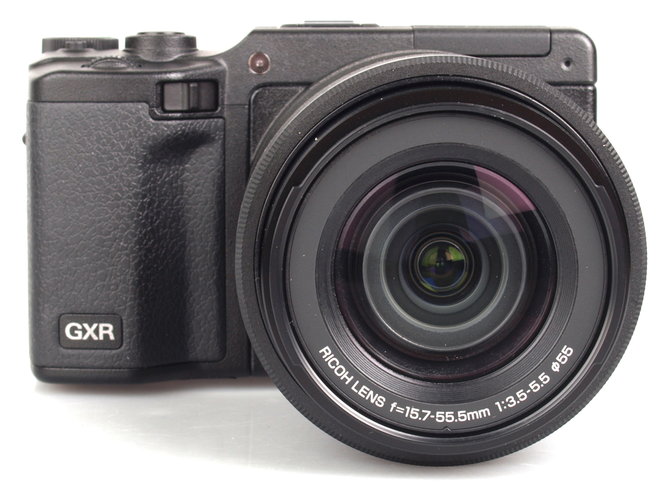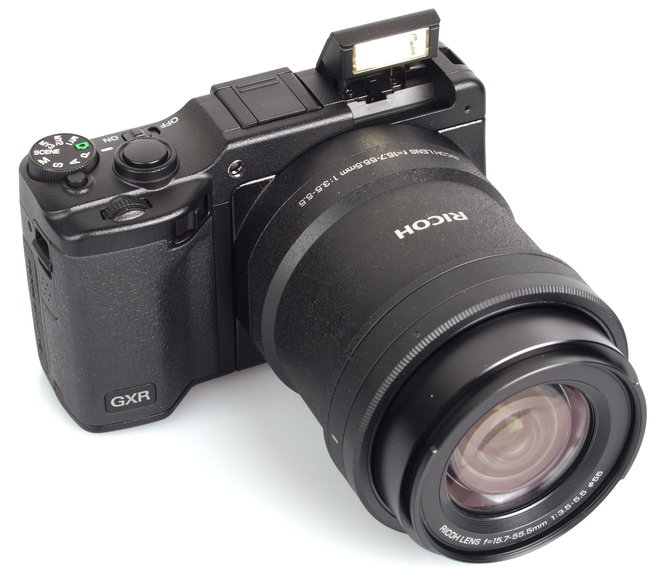Review Ricoh GXR A16 Camera Introduction:
The Ricoh GXR A16 15.7-55.5mm Lens / sensor unit, is the latest unit for the Ricoh GXR system, and slots into the cameras body as shown below. It features an APS-C sized sensor, as well as a wide-angle 15.7-55.5mm lens equivalent to 24 to 85 mm in 35mm terms. The Ricoh A16 24-85mm is the latest camera unit for the Ricoh GXR camera system, which combines the lens and sensor into a single interchangeable unit. The new A16 24-85mm module combines a 24-85mm lens f3.5-5.5 with a 9-group, 11-element configuration and a 16 megapixel APS-C CMOS image sensor. It simply slides into and out of the front of the GXR body, with virtually all of the features of the camera body available for any of the five units that are now available. The Ricoh GXR A16 24-85mm module additionally offers an ISO range of 100-3200, Smooth Imaging Engine IV processor, dynamic range compensation, ISO bracketing, an improved two-axis electronic level gauge and two different manual focusing aid.
Ricoh GXR A16 Camera Features:
As the Ricoh GXR body is common to all of the obtainable camera units, virtually all of the comments that they made in our original GXR review apply equally to the new A16 24-85mm camera unit. Than repeat them here, you ought to read the Ricoh GXR review first and then our specific comments about the A16 24-85mm unit below. With the A16 24-85mm camera unit fitted, the Ricoh GXR weighs 550g and measures 113.9 mmx74.7 mmx98.5 mm, including the battery and memory card. The camera body measures over three.5cm in depth, with the lens extending by 12cms from the front of the camera unit when set to full telephoto, dwarfing the GXR body.
The A16 unit has a 16 APS-C picture sensor and a 24-85mm lens f3.5-5.5 zoom lens. This is a matchless offering in the Ricoh range and is the third Ricoh camera module to feature the same-sized sensor that all of DSLRs use Ricoh GXR A16 Camera Charger. When the GXR is fitted with this unit, it is automatically in the same league as a DSLR or the other compact or mirror less cameras that have an APS-C sensor, like the Sony NEX range, Samsung NX cameras and the Pentax K-01. In theory the GXR with the A16 unit ought to deliver better picture quality than the likes of the Micro Thirds ranges from Panasonic and Olympus, the Nikon one method, and the Pentax Q.
The 24-85mm lens provides a focal range that is comparable to plenty of DSLR kit zooms, with the maximum apertures of f3.5 at 24mm wide-angle and f5.5 at 85mm telephoto also being similar. Other than a detachable filter ring, the A16 24-85mm has no controls at all, including zoom and rings, in lieu relying on the thumb-operated zoom buttons and the camera body's outside buttons and LCD screen in lieu. With the three.5x lens taking around three seconds to zoom from 24mm to 85mm, this makes the operation slow and far more awkward compared to a DSLR standard zoom lens.

The GXR A16 24-85mm is the third Ricoh GXR camera unit to offer HD video recording. There's film sizes obtainable - 1280x720, 640x480 and 320x240 pixels - all at 24 frames per second and all saved in the AVI file format, which regrettably does lead to some giant file sizes. Sound recording is mono only, and there's no advanced features like Wind cut or Pause / Restart as seen on other cameras, so Ricoh still have some work to do in this area.
In case you don't like composing your pics by holding the camera at arms length and taking a look at the LCD screen, there is also another way of framing your shots. You can additionally buy the removable optical viewfinder, the VF-2, which we'd recommend for the A16 24-85mm camera unit. These slots in to the hot-shoe on top of the camera, allowing you to hold the camera up to your eye and instantly giving the GXR the feel of a single-lens reflex camera.
The start-up time from turning the Ricoh GXR A16 24-85mm on to being prepared to take a picture is responsive at around two seconds. Focusing with the 24-85mm camera unit is quick in lovely light Ricoh GXR A16 Battery Charger, taking around 0.5 second, and the camera happily achieves focus most of the time inside or in low-light situations. It takes about 0.5 second to store a JPEG picture, allowing you to keep shooting as they are being recorded onto the memory card, and there is virtually no LCD blackout between each picture.
Shooting in RAW mode is also quick, with the GXR only taking around one second to store a RAW picture. In the quickest Continuous mode the camera shoots at two.5 frames per second but only for three RAW images, taking an additional five seconds to record the images before you can take another picture. For JPEGs, in single shot mode picture are recorded instantaneously, and in Continuous mode the A16 24-85mm shoots at the same two.5fps rate as RAW files but for up to 14 images.
The Ricoh GXR A16 24-85mm has a considerable number of distinctive features that other GXR camera units don't offer. In addition to a useful spot focusing mode, clever peaking function in the work of manual focusing which outlines the in-focus areas in color, and an electronic level for picture composition, the A16 has a brand spanking new Dynamic Range Compensation option. This increases the detail in the shadows and highlights, with different strengths available.
There's also new creative scene modes including high contrast black and white, miniaturize and toy camera, the ability to bracket the ISO speed, shoot only in RAW mode with no accompanying JPEG, and display over-saturated areas of the picture in the work of playback Ricoh Camera Charger. Finally, in case you continue to half-press the shutter button between shots, the focus, white balance, and exposure values are all maintained, useful for shooting under a constant light source, for example in a studio.
